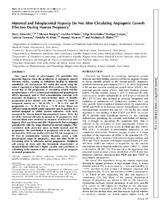Mostrar el registro sencillo del ítem
Maternal and fetoplacental hypoxia do not alter circulating angiogenec growth effectors during human pregnancy
| dc.contributor.author | Zamudio, Stacy | |
| dc.contributor.author | Borges, Marcus | |
| dc.contributor.author | Echalar, Lourdes | |
| dc.contributor.author | Kovalenko, Olga | |
| dc.contributor.author | Vargas, Enrique | |
| dc.contributor.author | Torricos, Tatiana | |
| dc.contributor.author | Al Khan, Abdulla | |
| dc.contributor.author | Álvarez, Manuel | |
| dc.contributor.author | Illsley, Nicholas P | |
| dc.date.accessioned | 2016-09-22T16:06:27Z | |
| dc.date.available | 2016-09-22T16:06:27Z | |
| dc.date.issued | 2014-02-27 | |
| dc.identifier.uri | http://repositorio.umsa.bo/xmlui/handle/123456789/7997 | |
| dc.description.abstract | Abstract. One causal model of preeclampsia (PE) postulates that placental hypoxia alters the production of angiogenic growth effectors (AGEs), causing an imbalance leading to maternal endothelial cell dysfunction. We tested this model using the natural experiment of high-altitude (HA) residence. We hypothesized that in HA pregnancies 1) circulating soluble fms-like tyrosine kinase 1 (sFlt-1) is increased and placental growth factor (PlGF) decreased, and 2) AGE concentrations correlate with measures of hypoxia. A cross-sectional study of healthy pregnancies at low altitude (LA) (400 m) versus HA (3600 m) compared normal (n ¼ 80 at HA, n ¼ 90 at LA) and PE pregnancies (n ¼ 20 PE at HA, n ¼ 19 PE at LA). Blood was collected using standard serum separation and, in parallel, by a method designed to inhibit platelet activation. AGEs were measured by enzyme-linked immunosorbent assays. AGEs did not differ between altitudes in normal or PE pregnancies. AGE concentrations were unrelated to measures of maternal or fetal hypoxia. PlGF was lower and sFlt-1 higher in PE, but overlapped considerably with the range observed in normal samples. PlGF correlated with placental mass in both normal and PE pregnancies. The contribution of peripheral cells to the values measured for AGEs was similar at LA and HA, but was greater in PE than in normotensive women. Hypoxia, across a wide physiological range in pregnancy, does not alter levels of circulating AGEs in otherwise normal pregnancies. Peripheral cell release of AGEs with the hemostasis characteristic of standard blood collection is highly variable and contributes to a doubling of the amount of sFlt-1 measured in PE as compared to normal pregnancies. | es_ES |
| dc.language.iso | en | es_ES |
| dc.publisher | Biol Reprod. | es_ES |
| dc.subject | ALTITUD | es_ES |
| dc.subject | PREECLAMPSIA | es_ES |
| dc.subject | HIPOXIA FETOPLACENTAL | es_ES |
| dc.title | Maternal and fetoplacental hypoxia do not alter circulating angiogenec growth effectors during human pregnancy | es_ES |
| dc.type | Article | es_ES |

